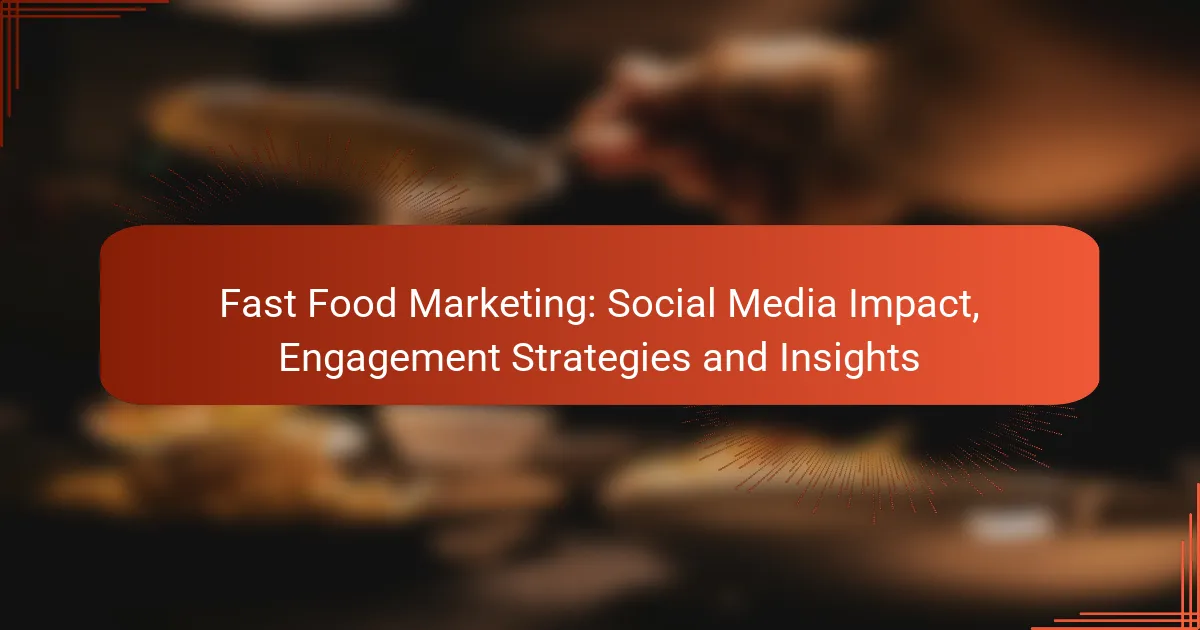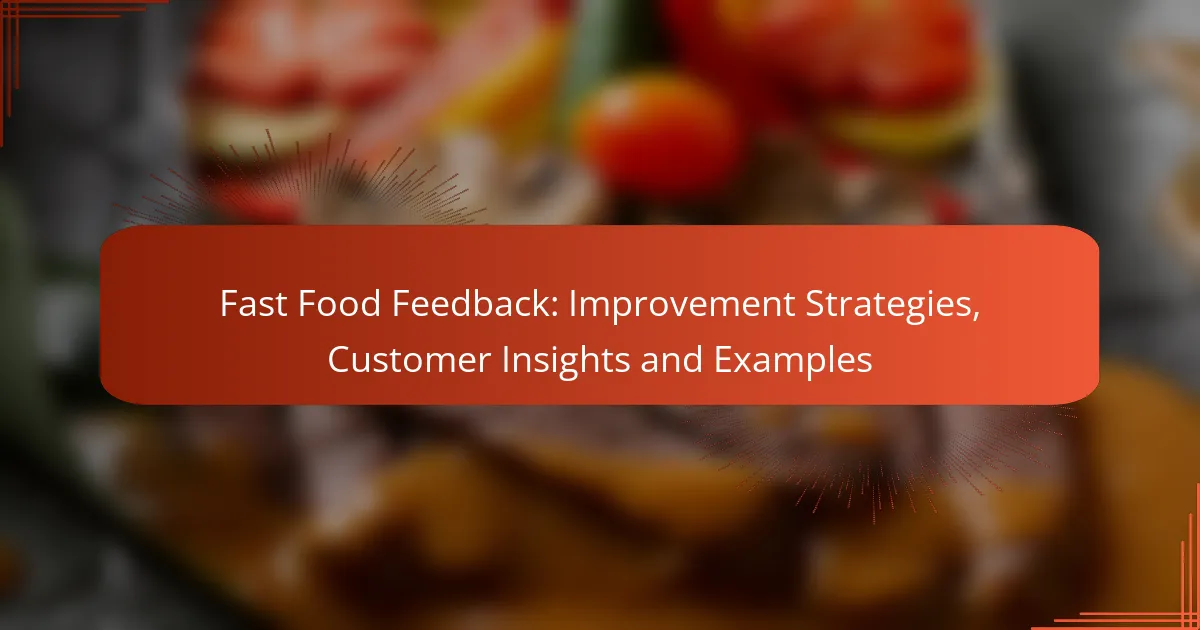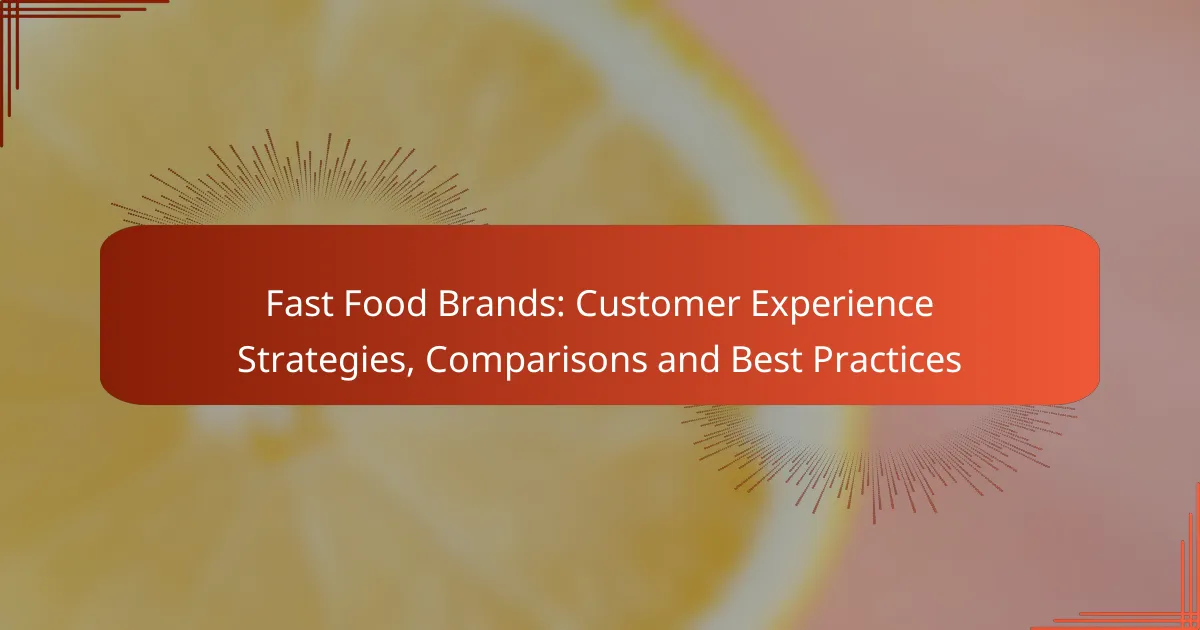Fast food marketing has been transformed by social media, which plays a crucial role in increasing brand visibility and fostering customer engagement. By utilizing platforms like Instagram, Facebook, and Twitter, fast food brands can effectively promote their products and connect with consumers in real-time. Engaging strategies such as user-generated content and influencer partnerships further enhance these interactions, driving loyalty and visibility among target audiences.

How does social media impact fast food marketing?
Social media significantly influences fast food marketing by enhancing brand visibility, fostering customer engagement, and providing real-time feedback. Fast food brands leverage platforms like Instagram, Facebook, and Twitter to connect with consumers, promoting their products and campaigns effectively.
Increased brand visibility
Social media platforms allow fast food brands to reach a vast audience quickly, increasing their visibility. By sharing visually appealing content, such as images and videos of menu items, brands can capture the attention of potential customers and create a memorable impression.
Utilizing trending hashtags and participating in viral challenges can further amplify a brand’s reach. For instance, a fast food chain might launch a new burger with a unique hashtag, encouraging customers to share their experiences online.
Enhanced customer engagement
Engagement on social media is crucial for fast food marketing, as it fosters a sense of community among consumers. Brands can interact directly with customers through comments, likes, and shares, creating a two-way communication channel that enhances loyalty.
Promotions such as giveaways or contests can significantly boost engagement. For example, a fast food restaurant might ask followers to post their favorite menu item for a chance to win free meals, encouraging participation and brand advocacy.
Real-time feedback and insights
Social media provides fast food brands with immediate feedback from customers, allowing them to gauge public perception. Monitoring comments and reviews can help identify areas for improvement, such as menu items or service quality.
Brands can also utilize social listening tools to track mentions and sentiment around their products. This data can guide marketing strategies and product development, ensuring alignment with customer preferences.
Targeted advertising opportunities
Fast food brands can leverage social media for targeted advertising, reaching specific demographics based on user data. Platforms like Facebook and Instagram offer advanced targeting options, allowing brands to tailor their ads to particular age groups, interests, and locations.
For effective campaigns, brands should focus on creating compelling ad content that resonates with their target audience. Utilizing eye-catching visuals and clear calls to action can enhance click-through rates and drive sales.

What are effective engagement strategies for fast food brands?
Effective engagement strategies for fast food brands focus on creating interactive and authentic connections with consumers. By leveraging user-generated content, influencer partnerships, interactive contests, and localized promotions, brands can enhance their visibility and foster loyalty among their target audience.
User-generated content campaigns
User-generated content (UGC) campaigns encourage customers to share their experiences with a brand’s products, often through social media. This strategy not only builds community but also provides authentic content that resonates with potential customers.
To implement a UGC campaign, brands can create specific hashtags and encourage followers to post photos or videos of their meals. For instance, a fast food chain might run a campaign where customers share their favorite meal combinations, offering a chance to win a gift card as an incentive.
Influencer partnerships
Influencer partnerships involve collaborating with social media personalities who have a significant following. These influencers can authentically promote a brand’s products to their audience, driving engagement and awareness.
When selecting influencers, brands should consider their alignment with the brand’s values and target demographic. A fast food brand might partner with a popular food blogger to showcase new menu items, leveraging the influencer’s credibility to attract their followers.
Interactive contests and polls
Interactive contests and polls engage customers by inviting them to participate in decision-making or creative activities. This strategy can boost engagement and create a sense of community among followers.
For example, a fast food brand could host a contest where customers submit their ideas for a new burger, with the winning entry featured on the menu. Polls can also be used to gauge customer preferences, such as asking followers to vote on their favorite side dish.
Localized promotions
Localized promotions tailor marketing efforts to specific geographic areas, making them more relevant to local consumers. This approach can enhance customer engagement by addressing regional tastes and preferences.
Fast food brands can run promotions that highlight local ingredients or celebrate regional events. For instance, a chain might offer a special discount on a popular local dish during a city festival, encouraging community participation and driving foot traffic to their locations.
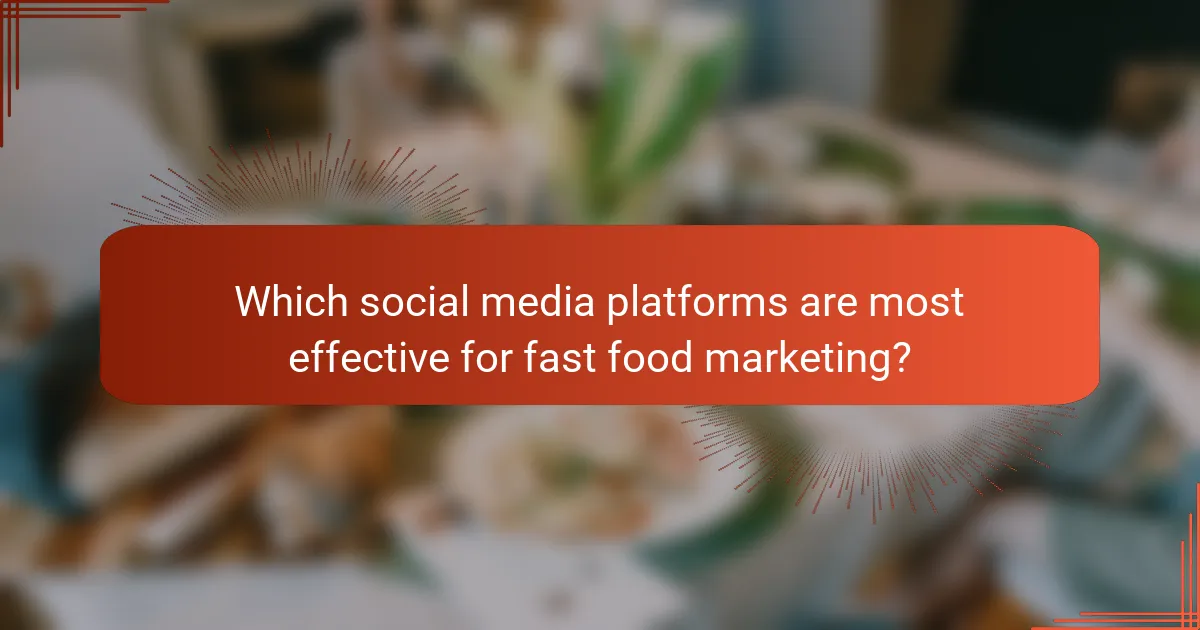
Which social media platforms are most effective for fast food marketing?
Fast food marketing thrives on platforms that emphasize visual content and engagement. Instagram, Facebook, Twitter, and TikTok each offer unique advantages that can enhance brand visibility and customer interaction.
Instagram for visual storytelling
Instagram is ideal for fast food marketing due to its focus on high-quality visuals. Brands can showcase mouth-watering images of their menu items, creating an enticing visual narrative that attracts followers.
Using features like Stories and Reels, fast food chains can engage users with behind-the-scenes content, promotions, and user-generated content. Consistent posting and aesthetic feeds can significantly boost brand loyalty.
Facebook for community building
Facebook excels in fostering community engagement, making it a powerful tool for fast food brands. Through groups and pages, businesses can interact directly with customers, share updates, and gather feedback.
Hosting events, promotions, or contests on Facebook encourages user participation and builds a sense of community. Regular interaction through comments and messages can strengthen customer relationships and enhance brand trust.
Twitter for real-time updates
Twitter is effective for fast food marketing due to its real-time communication capabilities. Brands can share timely updates, promotions, and news, keeping followers informed and engaged.
Utilizing trending hashtags and participating in conversations can amplify reach. Quick responses to customer inquiries or complaints can enhance brand reputation and customer satisfaction.
TikTok for viral trends
TikTok is rapidly becoming a key platform for fast food marketing, particularly among younger audiences. The platform’s emphasis on short, engaging videos allows brands to create fun and shareable content that can go viral.
Fast food chains can leverage popular challenges, trends, and collaborations with influencers to reach a wider audience. Creative, humorous, or unexpected content often resonates well, driving engagement and brand awareness.

What metrics should fast food brands track for social media success?
Fast food brands should focus on key metrics such as engagement rates, follower growth, conversion rates, and customer sentiment analysis to gauge their social media success. These metrics provide insights into audience interaction, brand popularity, and overall effectiveness of marketing strategies.
Engagement rates
Engagement rates measure the level of interaction users have with a brand’s content, including likes, shares, comments, and reactions. A higher engagement rate indicates that the content resonates well with the audience, which is crucial for fast food brands aiming to build community and loyalty.
To calculate engagement rates, divide the total interactions by the total followers and multiply by 100. Aim for engagement rates in the range of 1-5% as a benchmark, but remember that higher rates can vary by platform and audience demographics.
Follower growth
Follower growth tracks the increase in a brand’s social media audience over time. This metric is vital for understanding brand reach and potential market penetration. Fast food brands should monitor both the rate of new followers and any losses to identify trends.
Set specific growth targets, such as a monthly increase of 5-10% in followers. Regularly analyze which campaigns or content types drive the most growth, and adjust strategies accordingly to maintain momentum.
Conversion rates
Conversion rates measure the percentage of social media interactions that lead to desired actions, such as website visits, app downloads, or purchases. For fast food brands, tracking conversions helps assess the effectiveness of promotions and advertising campaigns.
To calculate conversion rates, divide the number of conversions by the total interactions and multiply by 100. A typical conversion rate for social media can range from 1-3%, but this can vary based on the campaign’s nature and target audience.
Customer sentiment analysis
Customer sentiment analysis involves assessing how consumers feel about a brand based on their social media interactions and comments. This metric helps fast food brands understand public perception and identify areas for improvement.
Utilize tools that analyze sentiment through keywords and phrases in comments and reviews. Regularly review sentiment trends to gauge the impact of marketing campaigns and adjust messaging to align with customer preferences. Aim for a balanced sentiment score, where positive feedback outweighs negative comments significantly.
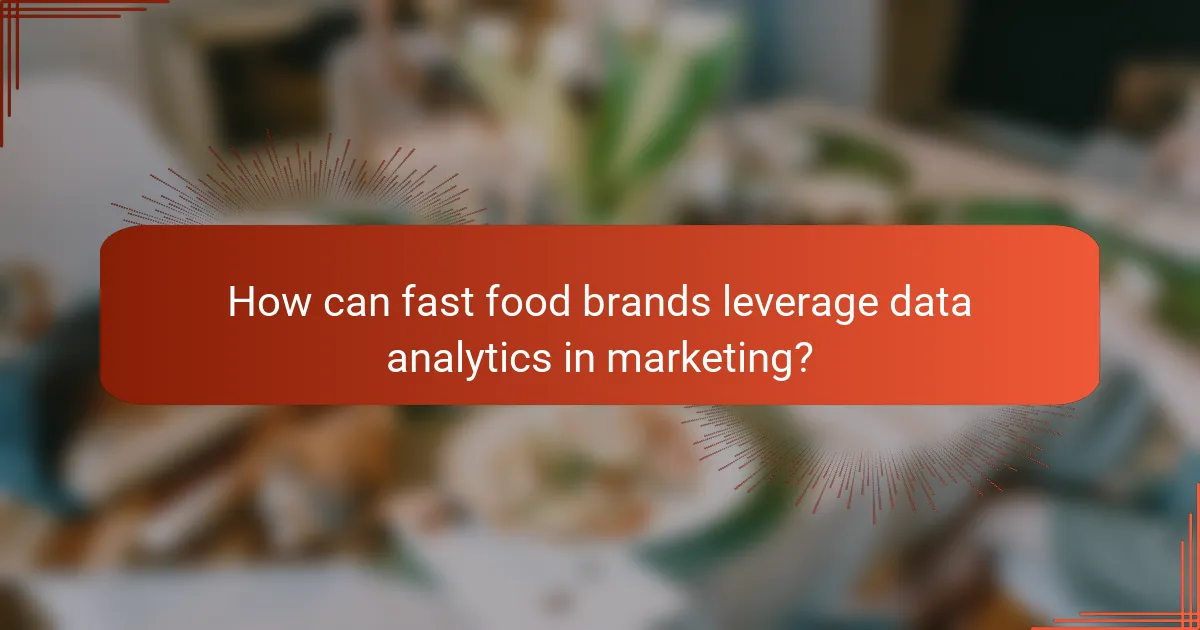
How can fast food brands leverage data analytics in marketing?
Fast food brands can leverage data analytics to enhance their marketing strategies by analyzing customer behavior, preferences, and trends. This approach allows them to tailor their offerings and promotional efforts to better meet consumer demands and improve engagement.
Identifying customer preferences
Data analytics helps fast food brands identify customer preferences by collecting and analyzing data from various sources, including social media, sales transactions, and customer feedback. By understanding what customers enjoy, brands can create targeted marketing campaigns that resonate with their audience.
For example, analyzing social media interactions can reveal popular menu items or trending flavors. Brands can use this information to develop limited-time offers or promotions that align with current consumer interests, thus driving sales and increasing customer loyalty.
To effectively identify customer preferences, fast food brands should implement tools such as customer surveys, loyalty programs, and social listening platforms. Regularly reviewing this data can help brands stay ahead of changing tastes and preferences, ensuring their marketing strategies remain relevant and effective.
